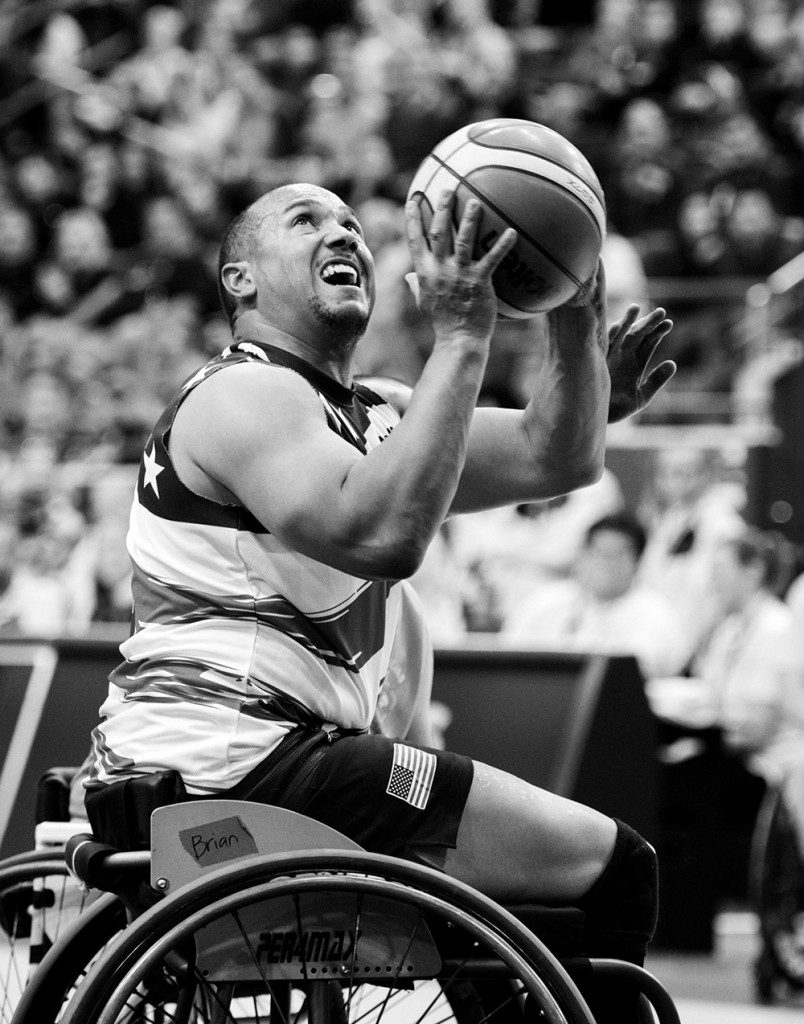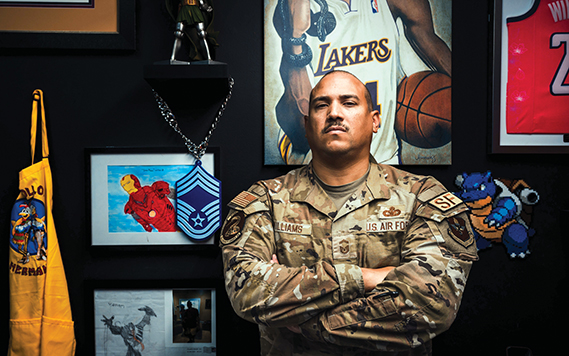It was April 25, 2012, in Forward Operating Base Pasab, Afghanistan, and the world was an endless sea of sand.
There, U.S. Air Force Staff Sgt. Brian Williams and his military working dog Carly sat surrounded by the bulky, wire mesh walls of HESCO barriers that had become as much a part of the terrain as the jagged rocks and scattered rubble around them.
“I was in a remote location in the middle of nowhere,” said Williams, now a senior master sergeant. “Just sitting there waiting for the arrival of the large Army unit we were tasked with.”
He and his MWD had been deployed to FOB Pasab for two months and were currently tasked with waiting for their Army counterparts to arrive before beginning their sweep of an Afghan village nearby.
Having been waiting since dawn, and it was now past noon, time seemed stretched thin. Hours slipped by as if caught in a tide of restless anticipation.
Finally, at just past 3 p.m., the distant rumble of trucks approaching stirred the air, and they were cleared to move.
“When things started moving, Carly would have this burst of excitement,” said Williams. “We both did.”
As they made their way forward, a snarky remark from an Army specialist that was eyeing Carly’s restless behavior caught William off guard.
“Your dog’s going to blow us all up, huh?” said the specialist.
Williams said he felt his anger flare.
“It was the type of comment I would usually let go,” said Williams. “But another MWD handler from our base had gotten injured that day, and I couldn’t shake a feeling of uneasiness.”
They pressed on, reaching the village, where the Army minesweepers were already at work, the mechanical hum of their equipment cutting through the heavy silence. Williams and Carly moved ahead of the others, carefully step-by-step, their pace deliberate.
They arrived at a compound and orders were given: Carly was to search it.
Williams unclipped Carly from his leash, paws scraping softly against the dusty floor as he began to search the rooms alone. He moved with a quiet precision, a dance between dog and honed fighter. But no alert came, signaling the area was clear of explosives.
As they reached a set of ancient and withered stairs, Williams noted the design was one you would expect to find in a different era, a foreign time.
Williams sent Carly to search the second floor so the unit could proceed upstairs. He moved to the base of the steps and sniffed, again no alert was signaled.
He climbed the stairs and entered another room at the top, but he did not return.
Usually, if Carly didn’t sense an explosive or a hostile, he would have returned or sent a warning of danger, but this time there was nothing.
Williams crept forward, listening for sounds of struggle. But there was only silence. The air was still.
“I am on the third step,” Williams said, his eyes far away. “And then time just freezes for me.”
There was no warning, no time to react. An improvised explosive device hidden under the steps, ripped through the earth beneath his feet. The pain was immediate, a searing heat followed by numbing stillness.
“I felt like I was hovering,” Williams said. “Like I was Iron Man, suspended in the air, weightless. I was up there forever.”
Eventually, gravity returned, and he crashed back down into consciousness.
“I could see that I had a compound fracture protruding from the skin on my left wrist,” said Williams. “My teeth were gone or dangling in my mouth.”
His mind scrambled, agony muffling everything except for a cold, striking realization. His left foot was nowhere to be found.
“I cried,” said Williams, his voice breaking. “I called for my mom.”
The world around him was morphed with pain, dust and frenzied voices. Soldiers scrambled to him, lifting him by his collar, securing tourniquets on his limbs and strapping him to a gurney.
The helicopter ride to the medics was a haze, a blur of worried faces and fading consciousness.
“I thought about my mom, my dad, my girlfriend,” said Williams. “Anything to keep me awake.”
Once they landed at the hospital, surrounded by the sterile scent of antiseptic and the quiet scurrying of nurses, he was finally allowed to sleep.
When he woke up days later under a fog of painkillers, Williams had not fully met the realization that things would be forever different now.
“When I got injured, I knew everything below my ankle was gone,” said Williams. “But while I was asleep, they had amputated higher.”
Out of fear of infection, Williams’ left leg was amputated above the knee.
In addition to losing his leg, he had suffered blown eardrums, traumatic brain injury, missing teeth, a compression fracture of the spine and left wrist compound fracture.
“According to the doctor, the only thing holding my hand together was my watch,” said Williams. “I had only worn a watch on deployments to see what time it was back home with my family.”
Throughout it all, Williams kept high spirits and felt relatively the same as he did before the injury. However, a week after his return to the U.S., his girlfriend was changing the bandage around his leg when something inside him shifted and he broke down
“I had promised my girlfriend that nothing would change when I came back,” said Williams, his voice softening. “And I had lied in dramatic fashion.”
The war had ended for him in some ways, but the battle for his military career was far from over.
“I’ve literally had to fight from the beginning to be in the Air Force,” said Williams.
It started when Williams joined Junior Reserve Officers’ Training Corps in high school.
“I did JROTC, but not because I planned on joining the military,” said Williams. “I just took it because I thought it was a class I could pass.”
The commander of his school’s JROTC unit, a retired Army colonel, did not want Williams included in the program. A feeling Williams said was mutual.
“I was definitely an interesting character in high school,” said Williams, a sparkle dancing in his eyes. “I was constantly in the principal’s office and testing authority.”
For two years his JROTC commandant attempted to get him kicked out.
“Because I continued to fulfill the bare minimum of my responsibilities,” said Williams. “There was nothing he could do about it.”
His senior year, after successfully completing four years in JROTC, the retired colonel refused to grant him the certificate verifying completion that members can take to enlist in the military for an automatic promotion.
His father, who retired in the Army, drove to the school to advocate for him.
“He told my father I did not deserve the joy of service to my country,” said Williams, shifting in his seat. “He wasn’t the first or last person to count me out.”
After graduating high school, Williams worked several minimum wage jobs before deciding he wanted something more for his life.
While he drove to the recruiter’s office, he said he told himself that he would try the Air Force first, and if they didn’t have a plan to get him ready to enlist that day, he would keep trying every branch until one did.
“In 48 hours after approaching my recruiter, I flew to the Military Entrance Processing Station and I picked security forces as my job,” said Williams. “Then they asked me if I wanted to fly out the next day or December.”
His first duty station after graduating BMT and the Air Force Security Forces Academy was Luke Air Force Base, Arizona, where he served the first eight years of his career.
“Luke AFB taught me a lot as my first assignment,” said Williams. “It shaped who I am and my foundations as an Airman.”
Some of the lessons Williams learned, were done the hard way.
“My first re-enlistment was met with some slight hesitation,” said Williams. “I received an Article 15 during my first four years.”

Williams continued to serve and after returning home from his fourth deployment, a supervisor pulled him aside and suggested that Williams volunteer to be a MWD handler and serve in the K-9 units.
Williams’ first deployment as a working dog handler was in 2010 with the 455th SFS at Bagram AB, Afghanistan.
“My dog was a drug dog,” said Williams. “I was unable to complete my deployment because my dog got a tumor the size of a softball and we both had to leave early.”
Before he was tasked with his sixth and final deployment, he was assigned Carly in 2011.
“Every relationship with a dog is different,” said Williams. “Prior to the injury in 2012, Carly didn’t want anything to do with me. That changed after.”
Williams was allowed to adopt Carly, who survived the IED with no injuries in 2013.
While having Carly with him contributed to his healing process, being an above the knee amputee meant a more complicated prosthetic process than those with below the knee cuts.
“I make it look doable, but I am a relatively high amputee,” said Williams. “To this day it is a continuous process of working and updating what kind of prosthetic offers me a higher quality of life.”
Throughout Williams recovery process, despite the mental and agonizing physical challenges of attempting to learn to walk on a prosthetic, he always avoided dwelling in the negatives of his new reality.
“Whenever I was feeling down about my situation,” said Williams. “I would look around in physical therapy at those who lost two or four limbs, and suddenly feel less sorry for myself.”
While Williams did not yet understand the graveness of the extent of his injuries and the difficulties returning to active-duty service would present, he did know he wanted to continue serving.
“A lot of things in the 10 years of service I had given at that point should have already pushed me to get out.” said Williams. “And it hadn’t.”
Williams said one of the most frustrating parts of his injury is that he would never be able to put a face or name to the person that placed the IED that took his leg.
“I wasn’t going to let that nameless person take my military service too,” said Williams. “Not when I had already fought so hard for it since the beginning.”
Williams was offered severance pay to start the beginning of a medical retirement from the Air Force, but he didn’t want to do that.
“The question I always get is ‘why did I stay?’” said Williams. “The real question is why not?”
While speaking with his care coordinator, a retired Air Force chief master sergeant, Williams was advised that he had almost made the ultimate sacrifice, and that he shouldn’t feel the need to give even more to the service.
“Everyone kept telling me I didn’t have to serve anymore and that I had given enough,” said Williams. “I remember thinking, ‘I know, but I want to so can we talk about that?’”
Williams said that he might have felt differently about wanting to fight to stay in if he had behaved recklessly or done something wrong to cause the incident, but he hadn’t so it wasn’t right to push him out.
“I was just doing my job,” said Williams. “I was just doing what I am supposed to do.”
With the help of a supportive member of Williams’ leadership, a blueprint was designed for how Williams would continue a career in the Air Force.
Even though he would be physically unfit to serve as a MWD handler again, there was precedent for those in security forces injured in service to become a technical school instructor at Lackland AFB in San Antonio, Texas.
“I didn’t necessarily want to go back to Lackland,” said Williams. “But I kept hearing about the word ‘impact.’”
Despite not wanting to return to Texas, Williams knew he could have a huge impact helping shape and support the next generation of security forces Airmen.
Before Williams could get there though, he had to face the MEB, where he says he felt continuously written off by medical personnel.
“I was constantly being met with ‘no’s’ and had to grind out the whole process,” said Williams. “I continuously advocated for myself all the way up to the Secretary of the Air Force.”
Despite his strongest efforts, Williams’ original board denied his return to active duty, which Williams appealed, accompanied by his commander and supervisor who traveled out of pocket to advocate for him in person.
Following the appeal hearing, Williams was yet again recommended to retire but would have to go through the evaluation process again before he could get a final answer. This time, he wrote a letter to the SECAF explaining his case and asking if he could approve his return to active duty.
With the SECAF approval, nearly two years after his injury, Williams was finally granted retainability.
“Every ‘no’ I got during that process didn’t deter me,” said Williams. “All I could think about was setting a precedent to give an opportunity for every Airman injured after me.”
“I make it look easy,” said Williams a smirk pulling on his lips. “But it’s not.”
In June, Williams competed in his first Warrior Games. While he was originally only interested in wheelchair basketball, he was pushed to try a multitude of sports. He now competes in volleyball, archery and track and field in addition to basketball. After seven years of competing in the Warrior Games, Williams has earned 30 medals across multiple events, over half of which are gold.
As of Nov. 4, 2024, it seems like Williams will be sticking around a bit longer.
Surrounded by his fellow Airmen and co-workers, some of which have been there since the beginning of his career, 56th FW leadership entered Williams’ office with a plaque to notify him that he was a chief master sergeant select.
Williams had reached the ninth, and highest, enlisted rank in the U.S. Air and Space Force, joining the top 1% of the enlisted force who make the final rank.
“To say that when I joined 23 years ago that making Chief was always in the cards for me would be a lie,” said Williams, smiling pensively. “But I hope that by joining the 1% I can provide continuous impacts for those around and under me, which is the reason I continue to serve.”










